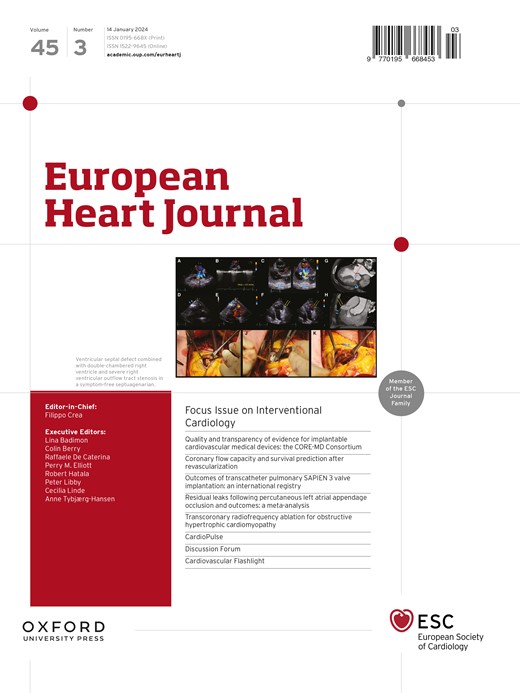Dietary carbohydrate quality, fibre-rich food intake, and left ventricular structure and function: the CARDIA study.
IF 35.6
1区 医学
Q1 CARDIAC & CARDIOVASCULAR SYSTEMS
引用次数: 0
Abstract
BACKGROUND AND AIMS Identifying lifestyle risk factors related to abnormal cardiac phenotypes, including structure and function, will be essential to prevent or slow down the progression to heart failure. Little is known about intakes of macronutrients and food groups, particularly carbohydrate (CHO) quality and fibre-rich foods, relative to cardiac phenotypes. Therefore, the association between CHO quality and cardiac phenotypes was examined in the Coronary Artery Risk Development in Young Adults (CARDIA) study. METHODS Trained interviewers conducted the CARDIA Diet History to gather dietary intake at exam years 0, 7, and 20. Cardiac phenotype measures were collected at exam years 25 and 30 via echocardiography. Linear mixed effects regression models were used to evaluate the association of CHO quality and fibre-rich food score averaged across years 0, 7, and 20 with cardiac phenotype measures at years 25 and 30. RESULTS Among the 3171 CARDIA participants, quartiles of CHO quality (defined using CHO:fibre ratio) were favourably associated with left ventricular (LV) mass index (Ptrend < .001) and global longitudinal strain (Ptrend < .001) after adjusting for demographic and lifestyle factors. Similarly, quartiles of fibre-rich food score (created based on daily intakes of whole grains, fruit, vegetables, nuts, and legumes) were favourably associated with LV mass index (Ptrend < .001), LV ejection fraction (Ptrend = .008), global longitudinal strain (Ptrend < .001), E/e' ratio (Ptrend = .02), and left atrial volume index (Ptrend = .02). Cardiac phenotype effect sizes between 10% and 26% of their respective standard deviations. CONCLUSIONS Higher quality of CHO and intake of fibre-rich foods were favourably associated with LV structure and function.膳食碳水化合物质量、富含纤维的食物摄入与左心室结构和功能:CARDIA研究。
背景和目的识别与心脏异常表型(包括结构和功能)相关的生活方式风险因素,对于预防或减缓心力衰竭的进展至关重要。关于大量营养素和食物种类的摄入,特别是碳水化合物(CHO)质量和富含纤维的食物,与心脏表型的关系知之甚少。因此,在年轻人冠状动脉风险发展(CARDIA)研究中,研究了CHO质量与心脏表型之间的关系。方法:受访人员进行了CARDIA饮食史调查,收集了第0年、第7年和第20年的饮食摄入量。在25岁和30岁时通过超声心动图收集心脏表型测量。使用线性混合效应回归模型评估CHO质量与0、7和20年平均富纤维食物评分与25和30年心脏表型测量之间的关系。结果在3171名CARDIA参与者中,在调整人口统计学和生活方式因素后,CHO质量(用CHO:纤维比定义)的四分位数与左心室(LV)质量指数(Ptrend < .001)和总体纵向应变(Ptrend < .001)呈正相关。同样,富含纤维食物评分的四分位数(基于全谷物、水果、蔬菜、坚果和豆类的每日摄入量)与左室质量指数(Ptrend < 0.001)、左室射血分数(Ptrend = 0.008)、左室纵向应变(Ptrend < 0.001)、E/ E′比(Ptrend = 0.02)和左房容积指数(Ptrend = 0.02)呈正相关。心脏表型效应大小在各自标准差的10%到26%之间。结论高质量的CHO和高纤维食物的摄入与左室结构和功能密切相关。
本文章由计算机程序翻译,如有差异,请以英文原文为准。
求助全文
约1分钟内获得全文
求助全文
来源期刊

European Heart Journal
医学-心血管系统
CiteScore
39.30
自引率
6.90%
发文量
3942
审稿时长
1 months
期刊介绍:
The European Heart Journal is a renowned international journal that focuses on cardiovascular medicine. It is published weekly and is the official journal of the European Society of Cardiology. This peer-reviewed journal is committed to publishing high-quality clinical and scientific material pertaining to all aspects of cardiovascular medicine. It covers a diverse range of topics including research findings, technical evaluations, and reviews. Moreover, the journal serves as a platform for the exchange of information and discussions on various aspects of cardiovascular medicine, including educational matters.
In addition to original papers on cardiovascular medicine and surgery, the European Heart Journal also presents reviews, clinical perspectives, ESC Guidelines, and editorial articles that highlight recent advancements in cardiology. Additionally, the journal actively encourages readers to share their thoughts and opinions through correspondence.
 求助内容:
求助内容: 应助结果提醒方式:
应助结果提醒方式:


